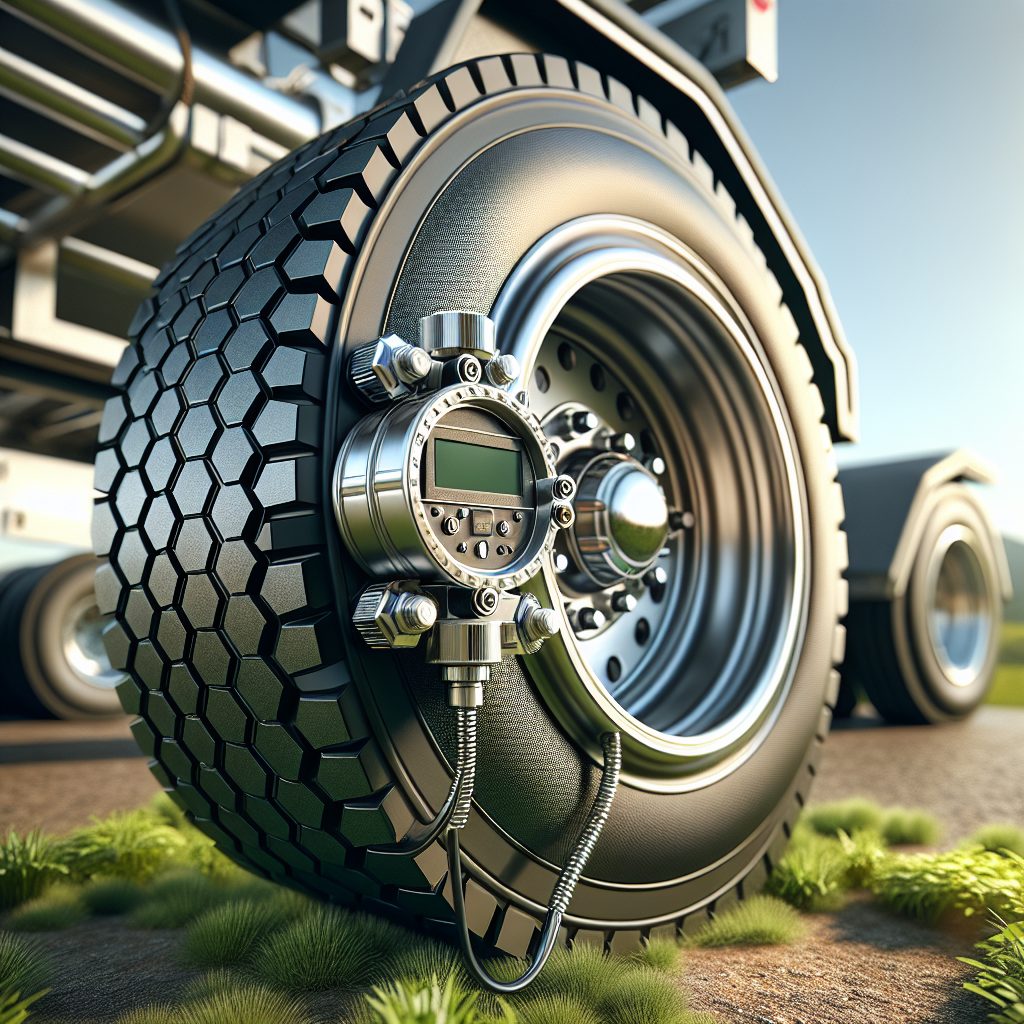Tire pressure sensors are critical components of modern vehicles, particularly for trailers that require optimal performance and safety. These sensors continuously monitor tire pressure, alerting the driver to any irregularities that could lead to tire failure. Understanding how does a tire pressure sensor work is essential for anyone looking to maintain their trailer effectively.
Proper tire pressure is vital for numerous reasons:
- Safety: Under-inflated tires can lead to blowouts, loss of control, and accidents.
- Fuel Efficiency: Correct tire pressure ensures better fuel economy, saving money on trips.
- Tire Longevity: Regular monitoring extends the life of tires, reducing replacement costs.
Equipped with state-of-the-art technology, tire pressure sensors provide real-time data, enabling drivers to make informed decisions about their trailer's condition. This feature is particularly valuable in preventing catastrophic failures that can arise from neglected tire maintenance.
To enhance your towing experience and ensure your trailer is always in top shape, tow with peace of mind, knowing that trailerwatchdog is standing guard. Visit trailerwatchdog.com to learn more about our innovative monitoring systems!
Understanding the Types of Tire Pressure Sensors

There are primarily two types of tire pressure sensors used in vehicles: direct tire pressure monitoring systems (TPMS) and indirect TPMS. Understanding these types is crucial for maintaining tire health and ensuring safety on the road.
1. Direct TPMS: This system utilizes pressure sensors mounted directly on each tire. These sensors measure the air pressure in real-time and send this information to the vehicle's onboard computer. If the pressure drops below a specific threshold, the system triggers a warning light on the dashboard. Direct TPMS is highly accurate and provides immediate feedback, making it a preferred choice for many modern vehicles.
2. Indirect TPMS: Instead of using pressure sensors in the tires, indirect TPMS relies on the vehicle's wheel speed sensors to detect changes in tire pressure. It estimates tire pressure by monitoring how fast each wheel is rotating. If a tire is under-inflated, it will rotate faster than properly inflated tires, alerting the driver to a potential issue. While indirect systems are less expensive and easier to install, they may not provide the same level of precision as direct systems.
Both types of sensors have their advantages and limitations. Direct TPMS offers real-time data and higher accuracy, while indirect TPMS can be easier to maintain and install. Understanding these differences can help trailer owners make informed decisions about which system best meets their needs.
How Tire Pressure Sensors Measure Pressure

Tire pressure sensors play a vital role in maintaining optimal tire performance and safety. But how exactly do these sensors measure pressure? The process varies slightly depending on whether the system is a direct TPMS or an indirect TPMS.
Direct TPMS: In direct systems, each tire is equipped with a sensor that directly measures the tire's air pressure. These sensors typically consist of a pressure transducer, which converts the physical pressure of the air inside the tire into an electrical signal. This signal is then transmitted wirelessly to the vehicle's onboard computer. The computer processes the data and displays it to the driver, often in real-time. As a result, any significant pressure drop is instantly communicated, allowing for quick action.
Indirect TPMS: In contrast, indirect systems do not measure tire pressure directly. Instead, they utilize the vehicle's wheel speed sensors as a proxy. By monitoring the rotational speed of each tire, the system can estimate tire pressure based on the assumption that a properly inflated tire will rotate at a consistent speed. If a tire loses pressure, it will rotate faster than its properly inflated counterparts, triggering an alert for the driver.
This method is less direct but still effective for detecting significant pressure changes. However, it is important to note that indirect TPMS may not provide precise pressure readings and may require periodic recalibration after tire rotations or replacements.
The Technology Behind Tire Pressure Sensors
The technology behind tire pressure sensors is an impressive blend of engineering and innovation, designed to enhance vehicle safety and performance. At the core of this technology is the sensor unit, which includes several components that work together to deliver accurate pressure data.
In direct tire pressure monitoring systems (TPMS), the sensor unit typically consists of:
- Pressure Transducer: This component is responsible for measuring the tire's air pressure. It uses a diaphragm that flexes under pressure, allowing the sensor to convert the mechanical force into an electrical signal.
- Microcontroller: The microcontroller processes the signals received from the pressure transducer. It interprets the data, determines if the pressure is within the acceptable range, and triggers alerts if it detects abnormalities.
- Wireless Transmitter: The transmitter sends the data wirelessly to the vehicle’s onboard computer. This is typically done using a low-power radio frequency, ensuring that the communication is both efficient and reliable.
In addition to these components, many modern tire pressure sensors are equipped with temperature sensors to account for the effects of heat on tire pressure. As tires heat up from driving, the air inside expands, which can lead to inflated pressure readings. By monitoring temperature, the system can provide more accurate pressure data.
Moreover, advancements in battery technology have led to the development of sensors with longer lifespans, reducing the need for frequent replacements. Some tire pressure sensors even feature self-calibrating capabilities, ensuring consistent accuracy regardless of tire pressure fluctuations.
Benefits of Using Tire Pressure Sensors

Utilizing tire pressure sensors offers a multitude of benefits that significantly enhance both vehicle safety and efficiency. As road safety becomes increasingly paramount, these sensors play a crucial role in ensuring that drivers are well-informed about their tire health.
Some key advantages of implementing tire pressure sensors include:
- Improved Safety: One of the primary benefits of tire pressure sensors is the enhancement of safety on the road. Under-inflated tires can lead to reduced traction, longer stopping distances, and increased risk of blowouts. By providing real-time pressure readings, drivers can maintain optimal tire pressure, thus minimizing these risks.
- Fuel Efficiency: Properly inflated tires contribute to better fuel economy. Studies show that for every 1 PSI drop in tire pressure, fuel efficiency can decrease by approximately 0.2%. Tire pressure sensors help ensure that tires are always at the correct pressure, which can lead to significant savings at the pump.
- Prolonged Tire Life: Consistently monitoring tire pressure can extend the life of tires. Under-inflation causes uneven wear patterns, while over-inflation can lead to premature tire damage. By maintaining optimal pressure levels, tire pressure sensors help in achieving maximum tire longevity.
- Enhanced Performance: Vehicles equipped with properly inflated tires exhibit improved handling, stability, and overall performance. Tire pressure sensors provide the necessary data to make informed adjustments, ensuring that drivers experience a smoother ride.
- Convenience: Many modern tire pressure sensors are integrated into the vehicle’s dashboard, providing real-time updates. This convenience removes the need for manual checks, allowing drivers to focus on the road without worrying about tire conditions.
Incorporating tire pressure sensors into your vehicle or trailer not only contributes to safety but also promotes efficiency and performance. By keeping an eye on tire health, drivers can enjoy peace of mind while navigating their journeys.
Conclusion on Tire Pressure Sensor Functionality

In conclusion, understanding how tire pressure sensors work is essential for anyone looking to enhance their driving experience and ensure safety on the road. These sensors provide critical data regarding tire pressure, which is a key factor in vehicle performance, fuel efficiency, and overall safety. By continuously monitoring tire health, they allow drivers to make informed decisions, preventing potentially hazardous situations caused by under-inflation or over-inflation.
Moreover, the integration of tire pressure sensors in smart trailers enables fleet operators to maintain optimal tire conditions, reducing the likelihood of costly breakdowns and enhancing the longevity of their tires. This technology not only improves safety but also contributes to significant cost savings over time.
As technology continues to evolve, embracing tire pressure sensors becomes increasingly crucial for anyone involved in towing or transporting goods. For those looking to invest in a smarter and safer trailer system, consider adopting advanced monitoring solutions.
Tow with peace of mind, knowing that trailerwatchdog is standing guard.

